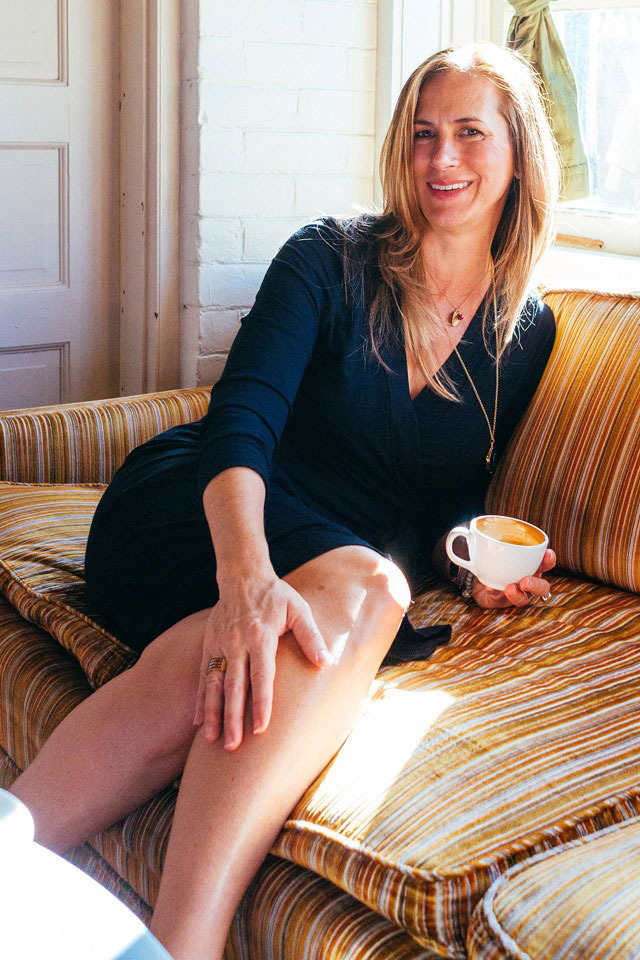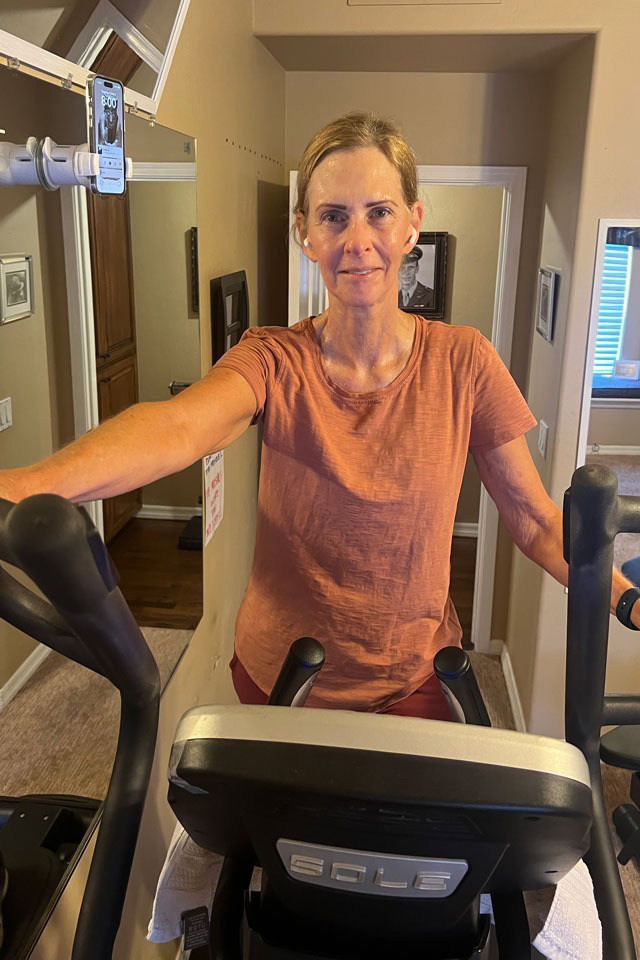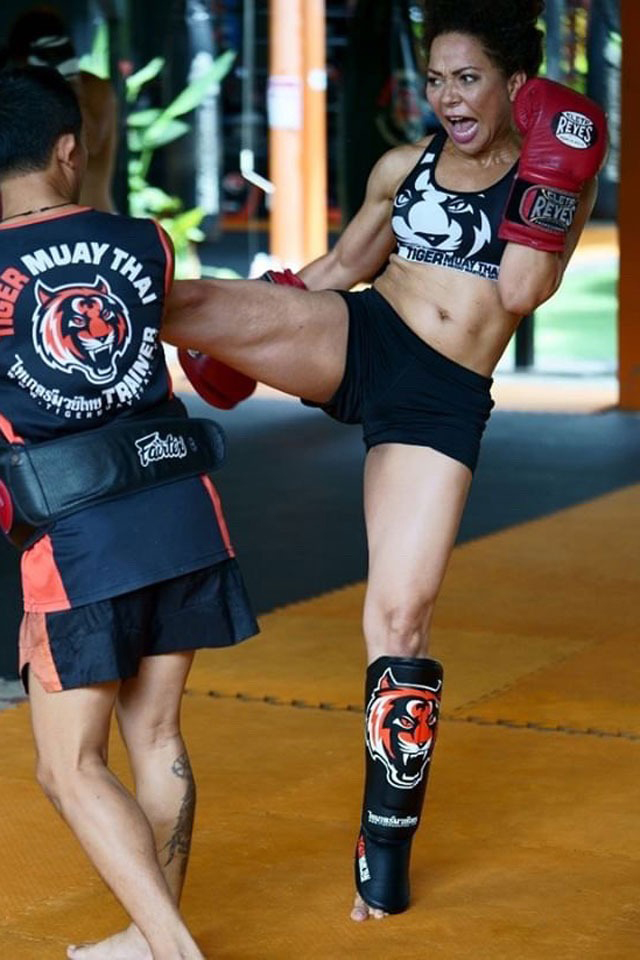科技大佬豪掷数百万求长寿,却拼不过这些女性

朱莉·吉布森·克拉克从不指望昂贵的医疗、各种小玩意或科学家团队“生物破解”自己的年龄。她坚持多吃蔬菜、锻炼和冥想。健康方面最大的支出是每月27美元的健身房会员和每月79美元的保健品。
这位55岁的单身母亲住在美国亚利桑那州菲尼克斯,当克拉克得知自己在网络长寿竞赛“重返青春奥运会”(Rejuvenation Olympics)中全球排名第二位时,她非常惊讶。该竞赛跟踪并为约4,000名参赛者的“生物”衰老速度排名。排名主要根据表观遗传学DNA测试,可以从中深入了解环境和生活方式对人类基因的影响。克拉克最新测试的结果显示,每过一年她会衰老0.665岁,测试会计算参与者六个月或更长时间后衰老速度得分的平均值。
在排行榜上,克拉克比美国最著名的生物黑客之一的排名还要靠前。有报道称,生物技术企业家、亿万富翁布莱恩·约翰逊每年在抗衰老方面花费200万美元,包括每天服用数十粒药物,还有30名医生组成的保健团队。约翰逊是这份排行榜的联合创始人,目前排名第六位。
近年来,长寿市场逐渐兴起,如今规模超过260亿美元,估计未来不到十年会接近翻一番。近来提供全身扫描、预防医学建议、保健品和锻炼方案的精品诊所激增,也让一直以来硅谷流行的追求长寿不再局限于小众市场。随着高端医疗保健行业的蓬勃发展,以前用户总体偏向男性,如今女性的人数和影响力也在增加。
《财富》杂志采访了几位在抵抗衰老影响方面比较成功的女性,发现很多人拒绝接受“生物黑客”这一说法和概念。她们介绍了如何用自己的方式定义长寿的目标——往往更追求全面的身心健康。一些人感觉比较排斥传统医学和研究,更愿意将健康掌握在自己的手中。不少人表示,追求长寿的初衷是想跟爱的人和关心的人多在一起。
“像刷牙一样”
克拉克既没有时间也没有资源跟科技界著名的生物黑客相比。据报道,推特(Twitter)的前首席执行官杰克·多尔西每天冥想两小时,徒步5英里(约8.047千米),每天洗桑拿和冰水浴;Bulletproof的创始人戴夫·阿斯普雷深信生物振动平台和冷冻治疗室等高科技疗法,他经常说打算活到180岁。
克拉克说,她的方法要超越“黑客”这一概念。“我不喜欢这个词。”从事招聘工作的克拉克对《财富》杂志表示,自己的收入不到10万美元。她认为自己“有健康意识”,不过当她得知在排行榜上的排名时(她提交生物标志物的渠道是长寿产品公司NOVOS的一项临床研究,她从该公司购买保健品),“还是惊讶得‘哇’了一声。”她补充道,“也证明了追求长寿这种事情其实就像刷牙一样。”

克拉克的每一天从凌晨4点45分到5点之间开始。送17岁的儿子上学之后,去健身房做力量和有氧运动。一夜禁食约16个小时,上午10点至11点之间吃第一顿饭。克拉克喜欢先蒸20分钟桑拿再洗个冷水澡,每周至少三次。工作时她每天吃16盎司(约453.59克)的蔬菜,其中包括生芹菜、萝卜、胡萝卜、辣椒和白灼西兰花,还有沙拉或汤。下午早些时候,她会冥想20分钟。
克拉克之所以下定决心从根本上改善健康,主要是因为十多年前一次恐慌的经历:她感觉早晨起床困难,经常疲劳,头发也掉得很快。后来检测出重金属中毒,部分原因是大学学陶瓷专业时,混合有毒釉料没戴口罩。治疗病情期间,她也开始关注自己的健康。
她说,十几岁的儿子是最大的动力。“我想尽可能多陪在他身边。”她告诉《财富》杂志。“尽量减少衰老造成的负面影响。”
追求长寿热背后的思潮
过去十年中,逾4万亿美元的健康行业快速增长,主要由女性消费者推动。但在更大的健康框架内,近年来大规模发展的竞争性、注重效果的追求长寿的活动更多偏向男性。
Primetime Partners的管理合伙人、创始人阿比·利维主要投资支持健康老龄化的保健公司,他表示:“在谈论长寿经济时,经常是指‘不老泉’神奇药丸和渴望永生的男性领袖,总是这种背景。”
一些人批评称,生物黑客似乎认为衰老能够当成可以预防的疾病,而非不可避免的过程,还指出衰老表现形式主要因素由遗传决定,不能仅看治疗和生活方式的选择。需要注意的是,生物年龄测试相对较新,市场上诸多测试的具体内容各不相同,因此“有效性不同”,精确程度也不一,新加坡国立大学(National University of Singapore)健康长寿中心(Centre for Healthy Longevity)的主任、Chi Longevity和健康长寿协会(Chi Longevity and The Healthy Longevity Society)的创始人安德烈娅·梅尔表示,健康长寿协会负责为长寿医疗机构制定实证标准。
尽管如此,长寿领域还是制造了一批明星,其中很多人都持有长寿业务公司,或者是长寿相关主题的作者和发言人。约翰逊、大卫·辛克莱和彼得·迪亚曼迪斯在20多岁时就投入时间和金钱尝试生物黑客,有时使用未经证实存在争议的疗法,曾经引起媒体的关注和嘲笑。约翰逊最近因为提出年轻血液疗法而受到抨击,尽管美国食品与药品管理局(FDA)警告称存在潜在健康风险且缺乏临床证据,他还是将儿子的血浆输入体内,希望能够减缓衰老。
由于该领域太新,客户群体性别细分的统计数据相对不足。尽管如此,该领域几家大型初创公司的客户群表明,用户中男性居多。测试生物年龄的TruDiagnostic表示,自2020年公司成立以来的30,000名“优化工具”客户群里,男性占57%,女性占43%。帮助约翰逊对抗衰老的医生奥利弗·佐尔曼对《财富》杂志表示,客户中三分之二是男性。在追踪生物健康指标的应用程序Groq Health上,男性客户占比为64%。
当约十年前尼古拉·康伦开始参加长寿科学会议时,她告诉《财富》杂志,性别差异极大。“男性的主导地位非常非常明显……这一领域的女性并不多。”Nuchido公司的创始人康伦表示,该公司主要提供抗衰老保健品。“长寿行业初期吸引的人群可能是希望提升表现,加强认知功能等方面优势的人。类似特征似乎天然比较吸引男性。”
根据伊齐基尔·伊曼纽尔的假设,四五十岁的男性生物黑客的动机是恐惧和自我。“处在这一年龄,男性气概受到威胁。身体开始往下走。”他对《财富》杂志表示。“也有努力跟后来者竞争的感觉。”伊曼纽尔是宾夕法尼亚大学(University of Pennsylvania)佩雷尔曼医学院(Perelman School of Medicine)医疗转型研究所的联合主任,也是美国进步中心(Center for American Progress)的高级研究员。他曾经撰写著名的专栏文章,讲述为何希望在75岁时去世,而且一直对追求长寿的行为持怀疑态度。他告诉《财富》杂志:“每个人都想永葆年轻,但不可能。”
50岁的波士顿营养学家迈克尔·鲁斯特加滕对《财富》杂志表示,他认为死亡是一种失败,不过他承认,“失败是肯定的,除非我能够找到生物破解的方法。”鲁斯特加滕告诉《财富》杂志,根据各种测试的平均值,他的生理年龄一直比实际小16岁到20岁。每周有三天他在一个半小时内吃掉90%的食物,每年七次测试表观遗传年龄。自2015年以来,他已经测了47次血液,每天摄入85克纤维,每天早上5点左右起床。
“我只是想让曲线的平缓阶段尽可能延长,或者说生理上尽可能延缓。”他对《财富》杂志表示。“说起早上起床的原因,对我来说是为了尽可能延长生存时间,尽可能保持健康,而且尽可能帮助他人实现同样的目标。”
他解释道,在自己身上实验并与YouTube频道上近2.2万名粉丝分享经验可能有点让人上瘾。“我的快乐在于解决一些没有人弄清,或者很少有人弄清的事情。”他说。“那就是我的兴奋剂。”
女性是“长寿运动的推动者”
随着追求长寿活动不断壮大,越来越多的女性参与其中,不过理由通常与男性不同。在Tally Health的首席执行官梅拉妮·戈尔迪看来非常明显,该公司的业务是客户提供表观遗传学年龄测试和预防性健康计划。2023年年初,该公司的27万名候补名单中男性还占主导地位,如今其客户群越发平衡:男性占53%,女性占47%。戈尔迪向女性客户尤其是更年期女性推广产品时,主要强调延长健康寿命,而不是一味对抗衰老,迎合社会上偏好年轻外貌的标准,即水灵灵光滑没有皱纹的肌肤。
“我认为,从成长的角度来看,女性将是长寿运动的重要推动力量。”戈尔迪说。“女性是很多购买决策的制定者。”事实上,女性在医疗支出中占了很大的一部分,而且仍然是家庭里主要的照顾者,很多人都夹在孩子和年迈的父母中间。
尤其随着职场女性年龄的增长,很多人感觉应该以其他方式补偿才可以维持优势并获得群体的尊重。“女性想让外貌看起来更年轻的门槛要高得多。”美国退休人员协会(American Association of Retired People)的高级顾问希瑟·廷斯利-菲克斯此前告诉《财富》杂志。“女性在年龄歧视方面的门槛更高;她们比男性更早也更频繁遭遇年龄歧视。”
埃米·哈迪森在“重返青春奥运会”排行榜上排名第五位,每年衰老率为0.73,她并没有每天吃保健品,也从未想过如何延长寿命,只是健康饮食,坚持运动,与他人联系以降低孤独造成的健康风险。63岁的哈迪森希望寿命尽可能延长,与四个孩子和11个孙子女一起生活,并尽可能长时间保持身心健康。
“我还有20年,也许25年左右,我只是在想,怎样才可以把接下来的时间过好?”哈迪森说。“活到84、85、86,对我而言已经很理想了。”

哈迪森自己做饭,选择少加工的食物。她还坚持每天一小时有氧运动,包括游泳和椭圆仪——她说过去50年来一直坚持。她很重视跟孩子和孙辈共度美好时光。她并非一味追求年轻,她说:“我只是珍惜生活的经历,珍惜年龄增长后更成熟的视角。”
哈迪森的女婿建议参加一项保健品试验时,她略有些矛盾地开始尝试。她同意把检测结果提交给“重返青春奥运会”,但花了两个月的时间才意识到跻身前列的重要意义。
“其实有些讽刺,因为我从来没有吃过维生素和保健品。”哈迪森说。“我63岁了,活了好几十年,目睹很多事情发生发展。所以,我不会对新鲜的伟大的事情太兴奋。”
尼科尔·布拉德福德热衷投资健康,对衰老心理学特别感兴趣。她对《财富》杂志表示,自己并不是“生物黑客”,尽管每月花700美元,每天吃106粒药,每六个月抽血一次,书中每项生物年龄测试都参加。“生物黑客是极为男性的行为。”布拉德福德说道。她说,在她看来,长寿不是竞争。

布拉德福德表示,照顾患有进行性心脏病的老年人期间就看得比较透彻。“大概每周我都会被提醒,如果不抓住机会认真对待衰老会变成什么样。”她说。“我过50岁关口时,最重要就是活力……确保我的活力与生活中创造的东西,以及我对世界的影响相称。”
十年过去,康伦再不会是长寿论坛和研究小组中唯一的女性。布拉德福德说想活到115岁,即便她最终超过该年龄不会惊讶。克拉克表示,期待儿子长大成人,计划儿子离家后环游世界,也对保持活力充满信心。
“到最后车轮总会从公交车上掉下来,我只想说:‘好吧,我的车轮不会掉得那么快。’”她说。“所以我会尽全力把公交车维护好。”(财富中文网)
译者:夏林
朱莉·吉布森·克拉克从不指望昂贵的医疗、各种小玩意或科学家团队“生物破解”自己的年龄。她坚持多吃蔬菜、锻炼和冥想。健康方面最大的支出是每月27美元的健身房会员和每月79美元的保健品。
这位55岁的单身母亲住在美国亚利桑那州菲尼克斯,当克拉克得知自己在网络长寿竞赛“重返青春奥运会”(Rejuvenation Olympics)中全球排名第二位时,她非常惊讶。该竞赛跟踪并为约4,000名参赛者的“生物”衰老速度排名。排名主要根据表观遗传学DNA测试,可以从中深入了解环境和生活方式对人类基因的影响。克拉克最新测试的结果显示,每过一年她会衰老0.665岁,测试会计算参与者六个月或更长时间后衰老速度得分的平均值。
在排行榜上,克拉克比美国最著名的生物黑客之一的排名还要靠前。有报道称,生物技术企业家、亿万富翁布莱恩·约翰逊每年在抗衰老方面花费200万美元,包括每天服用数十粒药物,还有30名医生组成的保健团队。约翰逊是这份排行榜的联合创始人,目前排名第六位。
近年来,长寿市场逐渐兴起,如今规模超过260亿美元,估计未来不到十年会接近翻一番。近来提供全身扫描、预防医学建议、保健品和锻炼方案的精品诊所激增,也让一直以来硅谷流行的追求长寿不再局限于小众市场。随着高端医疗保健行业的蓬勃发展,以前用户总体偏向男性,如今女性的人数和影响力也在增加。
《财富》杂志采访了几位在抵抗衰老影响方面比较成功的女性,发现很多人拒绝接受“生物黑客”这一说法和概念。她们介绍了如何用自己的方式定义长寿的目标——往往更追求全面的身心健康。一些人感觉比较排斥传统医学和研究,更愿意将健康掌握在自己的手中。不少人表示,追求长寿的初衷是想跟爱的人和关心的人多在一起。
“像刷牙一样”
克拉克既没有时间也没有资源跟科技界著名的生物黑客相比。据报道,推特(Twitter)的前首席执行官杰克·多尔西每天冥想两小时,徒步5英里(约8.047千米),每天洗桑拿和冰水浴;Bulletproof的创始人戴夫·阿斯普雷深信生物振动平台和冷冻治疗室等高科技疗法,他经常说打算活到180岁。
克拉克说,她的方法要超越“黑客”这一概念。“我不喜欢这个词。”从事招聘工作的克拉克对《财富》杂志表示,自己的收入不到10万美元。她认为自己“有健康意识”,不过当她得知在排行榜上的排名时(她提交生物标志物的渠道是长寿产品公司NOVOS的一项临床研究,她从该公司购买保健品),“还是惊讶得‘哇’了一声。”她补充道,“也证明了追求长寿这种事情其实就像刷牙一样。”
克拉克的每一天从凌晨4点45分到5点之间开始。送17岁的儿子上学之后,去健身房做力量和有氧运动。一夜禁食约16个小时,上午10点至11点之间吃第一顿饭。克拉克喜欢先蒸20分钟桑拿再洗个冷水澡,每周至少三次。工作时她每天吃16盎司(约453.59克)的蔬菜,其中包括生芹菜、萝卜、胡萝卜、辣椒和白灼西兰花,还有沙拉或汤。下午早些时候,她会冥想20分钟。
克拉克之所以下定决心从根本上改善健康,主要是因为十多年前一次恐慌的经历:她感觉早晨起床困难,经常疲劳,头发也掉得很快。后来检测出重金属中毒,部分原因是大学学陶瓷专业时,混合有毒釉料没戴口罩。治疗病情期间,她也开始关注自己的健康。
她说,十几岁的儿子是最大的动力。“我想尽可能多陪在他身边。”她告诉《财富》杂志。“尽量减少衰老造成的负面影响。”
追求长寿热背后的思潮
过去十年中,逾4万亿美元的健康行业快速增长,主要由女性消费者推动。但在更大的健康框架内,近年来大规模发展的竞争性、注重效果的追求长寿的活动更多偏向男性。
Primetime Partners的管理合伙人、创始人阿比·利维主要投资支持健康老龄化的保健公司,他表示:“在谈论长寿经济时,经常是指‘不老泉’神奇药丸和渴望永生的男性领袖,总是这种背景。”
一些人批评称,生物黑客似乎认为衰老能够当成可以预防的疾病,而非不可避免的过程,还指出衰老表现形式主要因素由遗传决定,不能仅看治疗和生活方式的选择。需要注意的是,生物年龄测试相对较新,市场上诸多测试的具体内容各不相同,因此“有效性不同”,精确程度也不一,新加坡国立大学(National University of Singapore)健康长寿中心(Centre for Healthy Longevity)的主任、Chi Longevity和健康长寿协会(Chi Longevity and The Healthy Longevity Society)的创始人安德烈娅·梅尔表示,健康长寿协会负责为长寿医疗机构制定实证标准。
尽管如此,长寿领域还是制造了一批明星,其中很多人都持有长寿业务公司,或者是长寿相关主题的作者和发言人。约翰逊、大卫·辛克莱和彼得·迪亚曼迪斯在20多岁时就投入时间和金钱尝试生物黑客,有时使用未经证实存在争议的疗法,曾经引起媒体的关注和嘲笑。约翰逊最近因为提出年轻血液疗法而受到抨击,尽管美国食品与药品管理局(FDA)警告称存在潜在健康风险且缺乏临床证据,他还是将儿子的血浆输入体内,希望能够减缓衰老。
由于该领域太新,客户群体性别细分的统计数据相对不足。尽管如此,该领域几家大型初创公司的客户群表明,用户中男性居多。测试生物年龄的TruDiagnostic表示,自2020年公司成立以来的30,000名“优化工具”客户群里,男性占57%,女性占43%。帮助约翰逊对抗衰老的医生奥利弗·佐尔曼对《财富》杂志表示,客户中三分之二是男性。在追踪生物健康指标的应用程序Groq Health上,男性客户占比为64%。
当约十年前尼古拉·康伦开始参加长寿科学会议时,她告诉《财富》杂志,性别差异极大。“男性的主导地位非常非常明显……这一领域的女性并不多。”Nuchido公司的创始人康伦表示,该公司主要提供抗衰老保健品。“长寿行业初期吸引的人群可能是希望提升表现,加强认知功能等方面优势的人。类似特征似乎天然比较吸引男性。”
根据伊齐基尔·伊曼纽尔的假设,四五十岁的男性生物黑客的动机是恐惧和自我。“处在这一年龄,男性气概受到威胁。身体开始往下走。”他对《财富》杂志表示。“也有努力跟后来者竞争的感觉。”伊曼纽尔是宾夕法尼亚大学(University of Pennsylvania)佩雷尔曼医学院(Perelman School of Medicine)医疗转型研究所的联合主任,也是美国进步中心(Center for American Progress)的高级研究员。他曾经撰写著名的专栏文章,讲述为何希望在75岁时去世,而且一直对追求长寿的行为持怀疑态度。他告诉《财富》杂志:“每个人都想永葆年轻,但不可能。”
50岁的波士顿营养学家迈克尔·鲁斯特加滕对《财富》杂志表示,他认为死亡是一种失败,不过他承认,“失败是肯定的,除非我能够找到生物破解的方法。”鲁斯特加滕告诉《财富》杂志,根据各种测试的平均值,他的生理年龄一直比实际小16岁到20岁。每周有三天他在一个半小时内吃掉90%的食物,每年七次测试表观遗传年龄。自2015年以来,他已经测了47次血液,每天摄入85克纤维,每天早上5点左右起床。
“我只是想让曲线的平缓阶段尽可能延长,或者说生理上尽可能延缓。”他对《财富》杂志表示。“说起早上起床的原因,对我来说是为了尽可能延长生存时间,尽可能保持健康,而且尽可能帮助他人实现同样的目标。”
他解释道,在自己身上实验并与YouTube频道上近2.2万名粉丝分享经验可能有点让人上瘾。“我的快乐在于解决一些没有人弄清,或者很少有人弄清的事情。”他说。“那就是我的兴奋剂。”
女性是“长寿运动的推动者”
随着追求长寿活动不断壮大,越来越多的女性参与其中,不过理由通常与男性不同。在Tally Health的首席执行官梅拉妮·戈尔迪看来非常明显,该公司的业务是客户提供表观遗传学年龄测试和预防性健康计划。2023年年初,该公司的27万名候补名单中男性还占主导地位,如今其客户群越发平衡:男性占53%,女性占47%。戈尔迪向女性客户尤其是更年期女性推广产品时,主要强调延长健康寿命,而不是一味对抗衰老,迎合社会上偏好年轻外貌的标准,即水灵灵光滑没有皱纹的肌肤。
“我认为,从成长的角度来看,女性将是长寿运动的重要推动力量。”戈尔迪说。“女性是很多购买决策的制定者。”事实上,女性在医疗支出中占了很大的一部分,而且仍然是家庭里主要的照顾者,很多人都夹在孩子和年迈的父母中间。
尤其随着职场女性年龄的增长,很多人感觉应该以其他方式补偿才可以维持优势并获得群体的尊重。“女性想让外貌看起来更年轻的门槛要高得多。”美国退休人员协会(American Association of Retired People)的高级顾问希瑟·廷斯利-菲克斯此前告诉《财富》杂志。“女性在年龄歧视方面的门槛更高;她们比男性更早也更频繁遭遇年龄歧视。”
埃米·哈迪森在“重返青春奥运会”排行榜上排名第五位,每年衰老率为0.73,她并没有每天吃保健品,也从未想过如何延长寿命,只是健康饮食,坚持运动,与他人联系以降低孤独造成的健康风险。63岁的哈迪森希望寿命尽可能延长,与四个孩子和11个孙子女一起生活,并尽可能长时间保持身心健康。
“我还有20年,也许25年左右,我只是在想,怎样才可以把接下来的时间过好?”哈迪森说。“活到84、85、86,对我而言已经很理想了。”
哈迪森自己做饭,选择少加工的食物。她还坚持每天一小时有氧运动,包括游泳和椭圆仪——她说过去50年来一直坚持。她很重视跟孩子和孙辈共度美好时光。她并非一味追求年轻,她说:“我只是珍惜生活的经历,珍惜年龄增长后更成熟的视角。”
哈迪森的女婿建议参加一项保健品试验时,她略有些矛盾地开始尝试。她同意把检测结果提交给“重返青春奥运会”,但花了两个月的时间才意识到跻身前列的重要意义。
“其实有些讽刺,因为我从来没有吃过维生素和保健品。”哈迪森说。“我63岁了,活了好几十年,目睹很多事情发生发展。所以,我不会对新鲜的伟大的事情太兴奋。”
尼科尔·布拉德福德热衷投资健康,对衰老心理学特别感兴趣。她对《财富》杂志表示,自己并不是“生物黑客”,尽管每月花700美元,每天吃106粒药,每六个月抽血一次,书中每项生物年龄测试都参加。“生物黑客是极为男性的行为。”布拉德福德说道。她说,在她看来,长寿不是竞争。
布拉德福德表示,照顾患有进行性心脏病的老年人期间就看得比较透彻。“大概每周我都会被提醒,如果不抓住机会认真对待衰老会变成什么样。”她说。“我过50岁关口时,最重要就是活力……确保我的活力与生活中创造的东西,以及我对世界的影响相称。”
十年过去,康伦再不会是长寿论坛和研究小组中唯一的女性。布拉德福德说想活到115岁,即便她最终超过该年龄不会惊讶。克拉克表示,期待儿子长大成人,计划儿子离家后环游世界,也对保持活力充满信心。
“到最后车轮总会从公交车上掉下来,我只想说:‘好吧,我的车轮不会掉得那么快。’”她说。“所以我会尽全力把公交车维护好。”(财富中文网)
译者:夏林
Julie Gibson Clark doesn’t use expensive medical treatments, gadgets, or a team of scientists to “biohack” her age. She sticks to a vegetable-rich diet, exercises and meditates. Her biggest health expenditures are a $27-a-month gym membership and an $79-a-month supplement subscription.
So the 55-year-old single mom in Phoenix, Arizona was surprised to learn she ranks at No.2 on the worldwide leaderboard of an online competitive longevity game, the Rejuvenation Olympics, which tracks and ranks about 4,000 participants’ pace of what’s sometimes called “biological” aging. It’s based on epigenetic DNA tests—which give an insight into how environment and lifestyle can influence how people’s genes work. Clark ages at 0.665 of a year for every additional chronological year, according to her most recent test, which takes into account the average of participants’ pace of aging scores after six months or more.
Clark is ahead of one of the country’s most famous biohackers on the leaderboard examining these averages: Bryan Johnson, the multi-millionaire biotech entrepreneur who spends a reported $2 million a year on a reverse-aging regimen that includes dozens of pills a day and a team of 30 doctors, co-created the leaderboard. He is currently in 6th place.
As the longevity market takes off—it’s now valued at over $26 billion and predicted to almost double in less than a decade—a proliferation of boutique healthcare clinics offering full-body scans, preventive medicine advice, supplement subscriptions, and exercise regimens have popularized the preoccupation with longevity beyond the niche that has long been obsessed with it in Silicon Valley. The denizens of this booming high-end healthcare sector have skewed male—but women’s numbers and influence are growing.
Fortune interviewed several of the women succeeding in staving off the effects of aging, and found that many of them rejected the term and concept of “biohacking.” They described how they are defining longevity goals in their own terms—often as an extension of holistic approaches to health. Some are driven by feeling shut out of traditional medicine and research, and led to take their health into their own hands. And many say they’re motivated by a desire to stick around for those they love and care for.
“Like brushing your teeth”
Clark has neither the time nor the resources to go to the lengths of the tech world’s famous biohackers—former Twitter CEO Jack Dorsey reportedly meditates two hours a day, walks five miles, and takes daily saunas and ice baths; Dave Asprey, founder of Bulletproof, swears by high tech treatments such as biovibration platforms and cryotherapy chambers, and he has often said he intends to live to 180.
Clark says her regime is more than a “hack” to her. “I don’t like that term,” Clark, a recruiter who says she makes less than $100,000, tells Fortune. She considers herself “health conscious,” but when she learned about her ranking on the leaderboard (she submitted her biomarkers via a clinical study from NOVOS, a longevity product company whose supplements she has taken), “I was like ‘wow,’ she says.” And, she adds, “That also confirmed this stuff has to just kind of be like brushing your teeth.”
Clark starts her day between 4:45 and 5 a.m. She sends her 17-year-old son off to school and then hits the gym for strength and cardio workouts. She fasts for about 16 hours overnight, eating her first meal between 10 and 11 a.m. At least three times a week, Clark uses a sauna for 20 minutes before a cold shower. While working, she eats 16 ounces of vegetables a day, a mix of raw celery, radishes, carrots, peppers, and blanched broccoli along with a salad or soup. She meditates for 20 minutes in the early afternoon.
Clark’s efforts to radically improve her health began over a decade ago after a scare: She was struggling to get up in the morning, feeling constantly fatigued, and losing her hair. She eventually tested positive for heavy metal poisoning—in part from her time as a ceramics major in college when she didn’t wear a mask mixing toxic glazes. As she treated her condition, she began to focus more intensely on her health.
Her teenage son, she says, offers a constant source of motivation. “I want to be there for him as long as possible,” she tells Fortune. “I want to minimize any negative repercussions of aging.”
The ethos behind the craze to live longer
The roaring growth of the over $4 trillion wellness industry over the last decade has been largely fueled by women consumers. But within that larger wellness framework, the competitive, performance-focused longevity movement that has grown massively in recent years has skewed more male.
“When we talked about the longevity economy, it was really focused on Fountain of Youth magic pills and alpha males wanting to live forever,” says Abby Levy, managing partner and founder at Primetime Partners, who invests in wellness companies with a focus on those that support healthy aging. “That was the backdrop.”
Some have criticized biohackers’ seeming belief that aging can be treated as a preventable disease instead of an inevitability, and pointed out that genetic determinants, more than treatments and lifestyle choices, account for a large part of how the ravages of aging manifest. And it should be noted that biological age tests are relatively new, and many on the market vary in exactly what they are testing and, therefore they “differ in validity” and in accuracy, says Dr. Andrea Maier, Director of the Centre for Healthy Longevity at the National University of Singapore and founder of Chi Longevity and The Healthy Longevity Society, which creates evidence-based standards for longevity clinics.
Still, the longevity space has created a set of stars, many with their own longevity companies or careers as authors and speakers on the topic. Johnson, as well as David Sinclair and Peter Diamandis, have drawn media attention and some derision as they dedicate their time and fortunes to biohacking their way back into their 20s, sometimes using controversial and unproven treatments. Johnson recently came under fire for his young blood treatments, where he had his son’s blood plasma infused into his body with the hope of mitigating aging, despite an FDA consumer warning against the practice because of potential health risks and a lack of clinical evidence.
Statistics on the gender breakdown of the industry’s customer base are hard to come by, especially given the novelty of the field. Still, the client bases of several large startups in the space show that the industry skews male. TruDiagnostic, which tests biological age, says that among its customer base of 30,000 “optimizers” since the company’s launch in 2020, men make up 57% and women make up 43%. Dr. Oliver Zolman, Johnson’s primary reverse aging doctor, tells Fortune that his clients are two-thirds men. At Groq Health, an app tracking biological health metrics, men make up 64% of customers.
When Nichola Conlon began attending longevity science conferences about a decade ago, she tells Fortune, the gender breakdown was striking. “It was very, very male dominant … there were not many women in the space,” says Conlon, the founder of Nuchido, a company that provides supplements aimed at reversing aging. “The early type of people it attracted were people that were maybe massively trying to get an edge on their performance, or their cognitive function or things like that. That sort of space just seemed to attract men.”
Dr. Ezekiel Emanuel hypothesizes that male biohackers in their 40s and 50s are motivated by fear and ego. “There’s a real threat to masculinity at that age. Things begin to decline,” he tells Fortune. “There’s also some sense of trying to compete with the next guy.” The co-director of the Healthcare Transformation Institute at the University of Pennsylvania Perelman School of Medicine and a senior fellow at the Center for American Progress, Emanuel famously penned an op-ed on why he hopes to die at 75 and has been a skeptical voice on the overall longevity movement. “Everyone would like to be young forever,” he tells Fortune, “But it isn’t going to happen.”
The Boston-based nutrition scientist Michael Lustgarten, 50, tells Fortune that he sees dying as a kind of failure—though he acknowledges, “Failure is for sure, unless I can figure out a way to biohack my way out of it.” Lustgarten, author of Conquer Aging or Die Trying, and scientist at the Jean Mayer USDA Human Nutrition Research Center on Aging at Tufts University, tells Fortune that he is consistently biologically between 16 and 20 years younger than his chronological age based on averages from various tests. He eats 90% of his diet within an hour and a half three days a week and tests his epigenetic age seven times a year. He has undergone 47 blood tests since 2015, eats 85 grams of fiber daily, and wakes up around 5 a.m. each morning.
“I’m talking about flattening the curve for as long as possible, or flattening it as much as physically possible,” he tells Fortune. “When it comes to what gets you out of bed in the morning, for me, it’s the idea of living as long as I physically can, in as good of health as I can and helping others to do the same.”
Experimenting on himself—and sharing what he learns with nearly 22K followers on his YouTube channel—can be somewhat addictive, he explains. “The happiness that I get is figuring out stuff that nobody’s figured out, or very few people have figured out,” he says. “That’s my drug.”
Women as “the drivers of this movement”
As the longevity movement expands, women are engaging more with it—but often it’s for different reasons than the male biohackers. That has been evident for Melanie Goldey, the CEO of Tally Health, which offers customers epigenetic age tests and preventative health plans. While men dominated the company’s 270,000 waitlist pre-launch at the beginning of 2023, its current client base is moving closer to parity: currently 53% male and 47% female. With a focus on appealing to women, especially those of menopausal age, Goldey markets her products by emphasizing extending healthspan, instead of defying age to conform to societal beauty standards that favor youthful looks—dewy, smooth skin instead of wrinkles.
“I think that women will be, from a growth perspective, the drivers of this movement,” Goldey says. “Women drive a lot of purchasing decisions.” Indeed, women account for a lot of health spending, and they still make up the bulk of caretakers in a family, with many finding themselves sandwiched between needing to care for children and an aging parent.
Especially as women age in the workforce, many feel like they have to compensate in other ways to stay ahead and respected by the pack. “There’s a much higher bar for women to appear younger,” Heather Tinsley-Fix, a senior advisor at the American Association of Retired People, previously told Fortune. “Women face a much higher bar with regard to ageism; they experience it earlier and more frequently than men.”
Amy Hardison, who is number five on the Rejuvenation Olympics leaderboard and is aging at at 0.73 of a year for every chronological year, never took daily supplements or thought that much about ways to extend her lifespan beyond the seemingly obvious: Eat healthy, stay moving, and stay connected to others to combat the health risks of loneliness. The 63-year-old wants to live as long as possible to stay in the lives of her four children and 11 grandchildren, and remain mentally and physically well as long as she can.
“I have 20 years, maybe 25 years or so, and it’s just, what do I want to do to make those the best possible?” Hardison says. “84, 85, 86 is plenty for me.”
Hardison cooks her own minimally processed food. She also swears by her one-hour daily aerobic exercise routine, including swimming and peddling on an elliptical bike—a discipline she says she has maintained for the last 50 years. And she prioritizes quality time with her kids and grandkids. She isn’t chasing youth, she says: “I just cherish the experience of life, and I cherish the perspective that comes from being older.”
When her son-in-law recommended she join a trial for a supplement, she gave it a go with some ambivalence. She agreed to submit her results for the Rejuvenation Olympics, but it took her two months to realize that being on the leader board meant something significant.
“It was pretty ironic, actually, that I even did it because I’ve never been into even taking vitamins and supplements,” she says. “Being 63, I have lived through several decades, and I have seen things come and go. So, I don’t get too excited about the latest and greatest.”
Nichol Bradford, an investor in wellness with a particular interest in the psychology of aging, tells Fortune that she doesn’t consider herself a “biohacker,” even though she spends $700 a month to take 106 pills a day, gets her blood drawn every six months, and has taken every biological age test in the book. “Biohacking is incredibly male,” Bradford says. For her, she says, longevity is not a competition.
The experience of taking care of an elder with progressive heart disease has offered an ongoing reality check, Bradford says. “I have sort of like a weekly reminder of what it looks like if you don’t take the chance to age well,” she says. “As I pass the 50 year mark, It’s really about vitality … making sure that I have the vitality to match the things that I’m creating in my life and the impact that I’m having on the world.”
A decade later, Conlon is far from the only woman at longevity conferences and research panels. Bradford wants to live to 115, she says, and she wouldn’t be surprised if she surpasses it. For her part, Clark says she looks forward to supporting her son as he grows into an adult. She also plans to travel across the globe when her son leaves home—confident in her ability to stay active.
“Eventually the wheels will fall off the bus, and I’m like, ‘well, mine aren’t falling off anytime soon,’” she says. “So I’m going to do everything I can to keep the bus in good order.”













